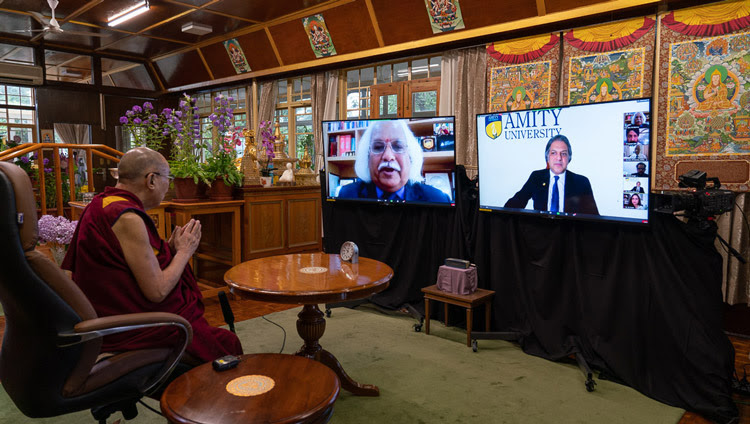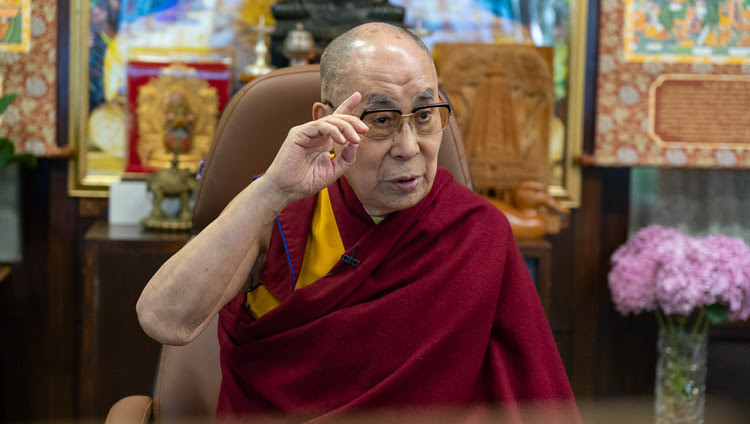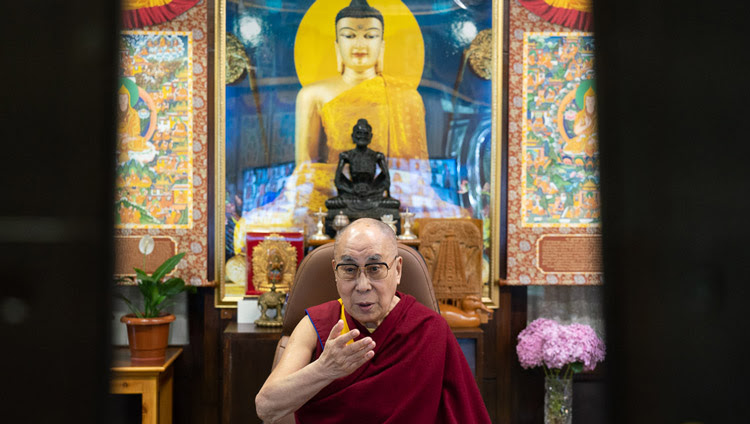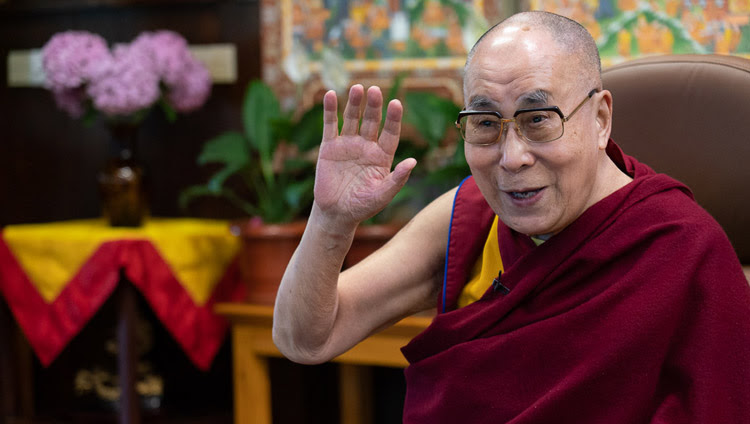Dharamshala, — This morning His Holiness the Dalai Lama took part in a ‘webinar’ organized by Amity University. When he entered the sitting room at his residence, he smiled, folded his hands in greeting and silently sat down.
Vice-chancellor of Amity University, Gurgaon, Prof PB Sharma greeted him, set the scene and asked, “How do we serve humanity, now?” The Chancellor, Dr Aseem Chauhan added that Amity University is founded on human values and working together. He asked, “What can we do to make our world a more compassionate, peaceful place?”
 Vice-chancellor of Amity University, Gurgaon, Prof PB Sharma and Chancellor, Dr Aseem Chauhan greeting His Holiness the Dalai Lama at the start if the interactive video conference with students from his residence in Dharamsala, HP, India on June 26, 2020. Photo by Ven Tenzin Jamphel“Thank you, it’s a great honour for me to talk to you and share some of my experience with you,” His Holiness replied. “I always feel especially close to my Indian brothers and sisters because I consider myself to be a student of Indian thought. In the eighth century, the Tibetan Emperor Trisong Detsen had close links to the Chinese Emperor. Tibet was subject to a strong Chinese Buddhist influence with its preference for meditation rather than study. Nevertheless, he opted instead to invite the Indian master, Shantarakshita, a great philosopher and logician from Nalanda University, to Tibet.
Vice-chancellor of Amity University, Gurgaon, Prof PB Sharma and Chancellor, Dr Aseem Chauhan greeting His Holiness the Dalai Lama at the start if the interactive video conference with students from his residence in Dharamsala, HP, India on June 26, 2020. Photo by Ven Tenzin Jamphel“Thank you, it’s a great honour for me to talk to you and share some of my experience with you,” His Holiness replied. “I always feel especially close to my Indian brothers and sisters because I consider myself to be a student of Indian thought. In the eighth century, the Tibetan Emperor Trisong Detsen had close links to the Chinese Emperor. Tibet was subject to a strong Chinese Buddhist influence with its preference for meditation rather than study. Nevertheless, he opted instead to invite the Indian master, Shantarakshita, a great philosopher and logician from Nalanda University, to Tibet.
“For more than 3000 years this country has upheld the concepts of ‘ahimsa’ or non-violence and ‘karuna’ or compassion. Buddha Shakyamuni was a product of these ideas as well as the practice for cultivating a calmly abiding mind, ‘shamatha’ and insight, ‘vipashyana’.
“We consider India to be the Arya Bhumi, a country that is highly developed in spiritual terms. As Buddhists, we Tibetans have long cherished the wish to make a pilgrimage to Bodhgaya at least once in our lives, much as Muslims go to Mecca.
“We Tibetans see ourselves as ‘chelas’ or loyal disciples of our Indian gurus, so there is a special bond between us. These days, however, it seems that the ‘gurus’ pay less attention to their ancient knowledge, something we have kept alive for more than 1000 years. We study as Shantarakshita taught us and we follow his advice. We take a logical approach and question everything. For example, the writings of Nagarjuna have been significant to us, which is why I recite several of his verses to myself every day.
 His Holiness the Dalai Lama speaking to Amity University students by video conference from his residence in Dharamsala, HP, India on June 26, 2020. Photo by Ven Tenzin Jamphel“In the end, the reason we study is to be able to tackle and reduce our destructive emotions. In my own case, my own daily practice consists of cultivating bodhichitta, a sense of altruism rooted in compassion. This aspiration is expressed in a verse by Shantideva:
His Holiness the Dalai Lama speaking to Amity University students by video conference from his residence in Dharamsala, HP, India on June 26, 2020. Photo by Ven Tenzin Jamphel“In the end, the reason we study is to be able to tackle and reduce our destructive emotions. In my own case, my own daily practice consists of cultivating bodhichitta, a sense of altruism rooted in compassion. This aspiration is expressed in a verse by Shantideva:
For as long as space endures
And for as long as living beings remain
Until then may I too abide
To dispel the misery of the world.
“All destructive emotions revolve around our self-centred attitudes — and bodhichitta serves to counter them.
“As far as philosophy is concerned, the Madhyamaka Buddhist view has much in common with what quantum physics has to tell us today. The Indian nuclear physicist Raja Ramanna once mentioned to me that quantum physics was a new discovery in the West, but Nagarjuna was already thinking along similar lines 2000 years ago. Both concur that nothing exists as it appears. Things may appear to exist objectively, but quantum physics states that deeper investigation reveals this isn’t true. Nagarjuna wrote that things are empty of independent existence. They exist dependent on other factors, which he describes as ‘pratityasamutpada’ or dependent arising.
“If you feel angry or afraid, but you investigate what it is about the object you are angry about or afraid of, you’ll mostly find that your feelings are mental projections. This is why those who give you trouble provide you with opportunities to cultivate patience and compassion — and this is why we say your enemy can be your teacher.
 His Holiness the Dalai Lama addressing students from Amity University by video conference from his residence in Dharamsala, HP, India on June 26, 2020. Photo by Ven Tenzin Jamphel“I sent a copy of a book we compiled called ‘Science and Philosophy in the Indian Buddhist Classics’ to professors in a university in China. And once they’d read it, they came to appreciate that Tibetan Buddhism is firmly rooted in the Nalanda Tradition, a scientific approach that we learned from India.”
His Holiness the Dalai Lama addressing students from Amity University by video conference from his residence in Dharamsala, HP, India on June 26, 2020. Photo by Ven Tenzin Jamphel“I sent a copy of a book we compiled called ‘Science and Philosophy in the Indian Buddhist Classics’ to professors in a university in China. And once they’d read it, they came to appreciate that Tibetan Buddhism is firmly rooted in the Nalanda Tradition, a scientific approach that we learned from India.”
His Holiness outlined his three or four commitments. First of all, as a human being himself, he considers his seven billion companions to be the same in being human. Because we are social animals, he observes, we are dependent on others and they are dependent on us. To see other people in terms of ‘us’ and ‘them’ stokes conflict that can result in bloodshed and killing. Therefore, he is committed to promoting the oneness of humanity.
As a Buddhist, His Holiness feels a strong responsibility to encourage inter-religious harmony. He considers it unthinkable that anyone should fight or kill in the name of religion. He concedes that different spiritual traditions propound different and contrasting philosophical points of view. Many Indian traditions describe a self or atman, separate from the body and mind, that goes on from life to life. The Buddha taught that the self is not something separate and independent. Rather, it is dependent on the body and mind. Despite such different views, all these traditions, Hindu, Buddhist, Christian, Muslim and Jewish, convey a common message of love. On such a basis, religious harmony is possible. And of this India is a living example.
His Holiness declared that the Tibetan people place their trust in him and so historically he has a responsibility to help them. However, since 2001 he has retired and devolved his political responsibility to an elected leadership. He feels a strong need to speak up for the protection of Tibet’s ecology, not just for the benefit of the Tibetan people, but also on behalf of all those across Asia who depend on rivers that rise in Tibet for their water.
Of corresponding importance is that Tibetans have kept ancient Indian knowledge alive, not just in terms of prayer and ritual, but by means of rigorous study. Tibetans have memorized the classic texts, studied their meaning, word by word, and tested their understanding through debate.
 His Holiness the Dalai Lama speaking to Amity University students by video conference from his residence in Dharamsala, HP, India on June 26, 2020. Photo by Ven Tenzin JamphelHis Holiness declared that since formally completing his own studies in 1959, he has continued to exert himself in practice. He has worked to increase his positive emotions and reduce those that are destructive. As a result, he says, he always has a smile on his face, a genuine, sincere smile, not an artificial one. This reflects, he said, that his mind is always at peace.
His Holiness the Dalai Lama speaking to Amity University students by video conference from his residence in Dharamsala, HP, India on June 26, 2020. Photo by Ven Tenzin JamphelHis Holiness declared that since formally completing his own studies in 1959, he has continued to exert himself in practice. He has worked to increase his positive emotions and reduce those that are destructive. As a result, he says, he always has a smile on his face, a genuine, sincere smile, not an artificial one. This reflects, he said, that his mind is always at peace.
“It’s on such a basis that I am a messenger of ancient Indian thought,” he disclosed, “especially with regard to ‘ahimsa’ and ‘karuna’ — compassion and non-violence.”
The first question put to him was about how to maintain peace and compassion in the face of violent forces.
“Non-violence springs from compassion,” His Holiness replied. “If you have compassion for others, your wish will be not to harm but to help them. If you apply your human intelligence, you may also recognise that anger destroys your peace of mind. It ruins the friendly feeling in families and communities. We are social animals, who need close friends. Compassion attracts friends. Anger and violence, on the other hand, are contrary to human nature. What we need to do is to find ways to live happily together.”
When another questioner suggested that kind-hearted people tend to suffer more than greedy people, His Holiness answered that he doesn’t think they do. In a society with primarily material goals, a society that doesn’t much acknowledge the idea of peace of mind, it may seem, that tough, competitive people are more superficially successful. But this judgement overlooks their inner world. Ancient Indian knowledge revealed by Hindu and Buddhist scholars provides a rich explanation of the workings of the mind. It reveals how to tackle destructive emotions and nurture those that are positive. The key is to combine this ancient understanding with modern education.
“In the last century, Mahatma Gandhi taught so clearly about the essential value of non-violence that he deeply influenced men like Nelson Mandela and Martin Luther King. In this century, we need to extend the message to include compassion.
“In India today, there remains a huge gap between rich and poor. We need to cultivate deeper concern for our human brothers and sisters. One way of approaching this is to revive a strong sense of compassion and non-violence in action. We can start by trying to train our minds.
“An old friend of mine was imprisoned for many years in Tibet. When he was finally released, he came to India. During our conversation about his experiences he told me he had sometimes felt in danger. Thinking he meant a danger to his life I asked him to tell me more and he replied that several times he felt he was in danger of losing compassion for his Chinese captors.”
Founder President of Amity University, Dr Ashok K Chauhan intervened to tell His Holiness how proud they were to listen to his words, assuring him that they will change Indian lives. He introduced His Holiness’s friend Dr Pradeep Chowbey who told him how delighted he was to know that he was so well.
“It is my duty to make whatever contribution I can to this country,” His Holiness responded. “Sharing the message of ancient India can reach across the world.
Noting the difficulties that Covid-19 has brought in its wake, a doctoral student asked what we can do to overcome depression. His Holiness told her,
 His Holiness the Dalai Lama waving goodbye to students from Amity University at the conclusion their interactive video conference from his residence in Dharamsala, HP, India on June 26, 2020. Photo by Ven Tenzin Jamphel“One of the approaches that I personally find useful is to cultivate the thought: If the situation or problem is such that it can be remedied, then there is no need to worry about it. In other words, if there is a solution or a way out of the difficulty, then you do not need to be overwhelmed by it. The appropriate action is to seek its solution. Then it is clearly more sensible to spend your energy focussing on the solution rather than worrying about the problem. Alternatively, if there is no solution, no possibility of resolution, then there is also no point in being worried about it, because you cannot do anything about it anyway. In that case, the sooner you accept this fact, the easier it will be for you. This formula, of course, implies directly confronting the problem and taking a realistic view of it. It’s very practical.”
His Holiness the Dalai Lama waving goodbye to students from Amity University at the conclusion their interactive video conference from his residence in Dharamsala, HP, India on June 26, 2020. Photo by Ven Tenzin Jamphel“One of the approaches that I personally find useful is to cultivate the thought: If the situation or problem is such that it can be remedied, then there is no need to worry about it. In other words, if there is a solution or a way out of the difficulty, then you do not need to be overwhelmed by it. The appropriate action is to seek its solution. Then it is clearly more sensible to spend your energy focussing on the solution rather than worrying about the problem. Alternatively, if there is no solution, no possibility of resolution, then there is also no point in being worried about it, because you cannot do anything about it anyway. In that case, the sooner you accept this fact, the easier it will be for you. This formula, of course, implies directly confronting the problem and taking a realistic view of it. It’s very practical.”
Asked whether he will choose to come back as the Dalai Lama, His Holiness retorted,
“That’s my private business. However, I’ve already told you my favourite prayer and the infinite aspiration that involves. We are all part of human society, so the purpose of our lives is not to make trouble, but to serve others in any way we can. We’re all driven by self-interest to some extent, but cultivating concern for others is a wise way of fulfilling our own self-interest.“
Prof PB Sharma thanked His Holiness on behalf or Amity University for sharing his time with them. His Holiness folded his hands together and smiled as the meeting came to a close.












